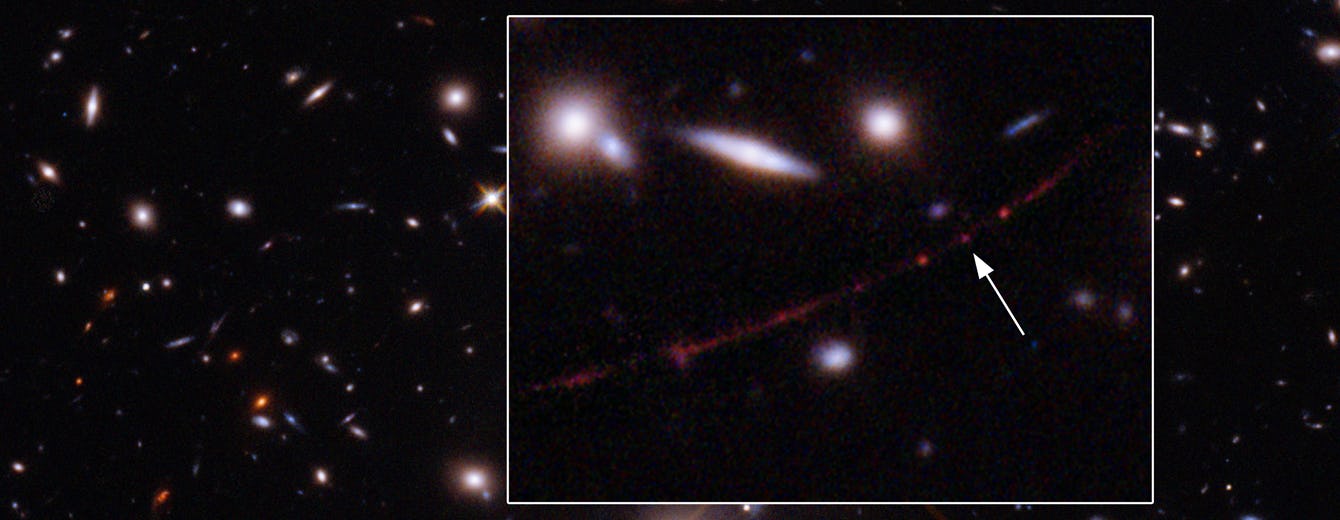
Astronomers used a naturally occurring “telescope” to peer at a very distant, gargantuan star, estimated to be an incredible 50 times the mass of our Sun.
The technique, known as gravitational lensing, is not new to science — but the method employed by the Hubble Space Telescope team to view it may provide a fresh view of our universe’s early days. The faraway star they spotted was only born about 900 million years after the Big Bang.
What’s new — Telescopes are constrained by the amount of light they can gather. Distant objects are therefore very difficult to see, as there is less light to collect from those objects. This light-gathering problem is true even of powerful Hubble.
Gravitational lensing, however, allows astronomers to use a massive foreground object — in this case, stars within a star cluster — to bend and focus the light from something interesting in the background. Massive objects in space deform space-time around them, allowing them to act like a magnifying glass, amplifying light from the background object. The effect was first predicted by Albert Einstein’s theory of general relativity.
“With the current Hubble data, we couldn't really say a whole lot, but we could tell from the brightness of the star and how highly magnified it was that it has to be a very large, very bright star,” lead author Brian Welch, a Ph.D. candidate in astronomy and astrophysics at Johns Hopkins University, tells Inverse.
He led a study published in Nature on Wednesday that will open up a new avenue of research for his team. The newly launched James Webb Space Telescope is already scheduled to look at this same object in even higher definition than Hubble, after its commissioning and early science program expected to complete in 2023.

Follow-up data from Webb in infrared light, Welch added, will scrutinize the star’s spectrum, or signature of light. Spectral data allows astronomers to look for individual elements within the star. Learning about the star’s composition will tell astronomers about the star’s life history, age and — potentially — where the star fits in with the early evolution of the universe.
Webb’s wavelengths go much deeper into infrared than Hubble. It also flies further in space and away from the stray light of Earth, at a stable Marsward gravitational zone known as Lagrange Point 2. Webb’s infrared eyes, its deep space location, and its higher definition will all contribute to gathering a detailed spectrum of this distant star, Welch says.
“With Webb looking at [the star], we will get a spectrum so we can see what temperature it is, and get some more constraints on what type of star this actually is,” says Welch, who also works at NASA’s Goddard Space Flight Center in Maryland.
Why it matters — Gravitational lensing allows astronomers to spy on objects born earlier in the universe’s history. Part of Webb’s mandate will be to peer across 13.5 billion years of time to learn about the first stars and galaxies that were formed, according to NASA.
Webb’s infrared vision makes it an ideal observatory to examine these early stars, which are receding away from us due to the ongoing expansion of the universe. The stars are highly redshifted, meaning that their light is shifted towards the red edge of the spectrum due to the stars’ light stretching as they recede.
The astronomers, however, got lucky with this find as the star is being lensed by a foreground star cluster, called WHL0137–08. Webb, researchers hope, will spot several more star clusters that can lens background stars for detailed study, Welch says.
If Webb can do so during its projected 20-year lifespan, that will open up the field of microlensing as never before. Usually, astronomers only get a single shot from a single star. They also usually see the event after the fact, in archival data.
What’s next — Because transiting events are usually so tough to spot, another astronomer says Webb shouldn’t be our only tool for lensing studies. A wide-field space telescope would be a better approach to catch more chance events, as such an observatory would see large swaths of the sky at once.
NASA plans to launch the Nancy Grace Roman Space Telescope in 2027 to image wider star fields than Hubble, with equivalent resolution. “It will give you [Hubble’s] kind of images with a cadence every few days,” Alexander Kaurov, an astrophysicist and visiting scholar in interdisciplinary studies at the Institute for Advanced Study in Princeton, New Jersey, tells Inverse.
Kaurov, who has published several studies on transiting events, says the Roman telescope would provide “much more information” on one-time events. For example, a 2019 paper in The Astrophysical Journal, led by Kaurov, identified a probable blue supergiant moving across a background star cluster called MACS J0416.1- 2403.
Karuov’s team only caught this event because the cluster was imaged repeatedly by Hubble on an unrelated program; the archival images his team later reviewed showed uneven brightness changes best explained by a moving star. It’s not often that Hubble gets to look at a single object repeatedly, Kaurov says, so Roman’s wider field may open up the skies to more observations of one-time transients.
If a magnifying star passes across a huge background structure like a galaxy cluster, Kaurov noted, the star provides a glimpse of what the cluster looks like in high definition — including the granularity of normal matter and dark matter, both of which are important to learning about a galaxy’s evolution or history. But it’s only a glimpse, highly subject to change.
While Kaurov had not yet reviewed Welch’s embargoed research, he says transient events are typically so short that it’s difficult to see the composition of these early galaxies. He added the hope is Roman “will give us some statistical validity” in assessing how individual objects magnify their background subjects, since it will be looking at more objects at once.







